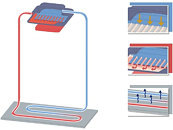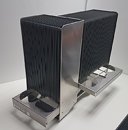Thursday, March 30th 2017
Kickstarted - Calyos NSG S0 Fanless Chassis With Phase Change Cooling
Kickstarted pieces of tech aren't usually covered here, but knowing the community, I'd say this is an interesting take on traditional cooling systems. I, for one, know how much I loathe the sound of spinning fans - but I think I'm in the majority here. And this case by Calyos promises to put an end to all of those, in a much cleaner, environmental-friendly way that doesn't involve dipping your thousands of dollars worth of hardware in something resembling cooking oil.The production chassis is designed by France's modding duo WaterMod, which improved upon the original open-frame concept design both in terms of performance and aesthetics. The usage of Phase Change cooling through two cooling blocks - one for the GPU, another for the CPU) makes away with fans, pumps, water, and any other assorted cooling techniques that involve calling upon the decibel gods.At time of writing, 124,490€ have already been pledged out of a 150,000€ goal. The entrance fee for this chassis is 549€ (at time of writing, only 94 out of a total of 200 units being sold at this "Early Bird" Special price are available; the "Super Early Bird" level at 479€ is all sold out already). For that pricing, you can shave from your investment any amount of fans, AIOs, or custom liquid-cooling loops that might be thinking of investing in - those are rendered obsolete by this chassis.
Whispers: and if you want to spend around 7,999€ for one of these babies so you can create your own design from scratch... they even give you the chance to do so.
Sources:
Kickstarter, ETeknix
Whispers: and if you want to spend around 7,999€ for one of these babies so you can create your own design from scratch... they even give you the chance to do so.







40 Comments on Kickstarted - Calyos NSG S0 Fanless Chassis With Phase Change Cooling
I actually kind of like this case. It has a nice look to it if I ever get back to caring about showcasing my gaming rig which I doubt will ever happen.
And compressor is.. where?
Seems tad bit too small to be effective TBH. In case you wonder how these things work or how to build one, I suggest www.xtremesystems.org/forums/ ..
This seems different to what I saw tho..
And oh my god look
Last edited by a moderator: Today at 4:51 PM
sorry must do better moderator (you know who you are :lovetpu: )
Thanks to everyone for the humorous corrections :laugh: And thanks @TheLostSwede for being the first to bring it up :)
You have heard of a vapor changer and/or heat pipe before, correct?
The powered (compressor, electrical, or combustion) phase change coolers are for creating cooling below ambient temperature. This phase change cooler acts more like your traditional water cooler to create cooling above ambient temperature. The phase change is used to create efficiency and a natural flow.
When I grew up, my parents had a refrigerator which was powered by nothing more than a burning kerosene flame. The flame caused a phase change with a strong enough upward flow of vapor in the tube, that it had a enough high-side and low-side pressure to cool items in the refrigerator to sub-ambient temperature. Google refrigeration if you don't understand "evaporator", "condenser", "expansion valve", and how any source with enough energy can make a specially designed refrigerator of enough size work.
For what it is worth, I have owned 2 sub-zero cooling phase change coolers of the type you originally referred to. I am aware of them and understand your question.
There is no zero-fan solution.
It does not exist. The most important part of any closed system is airflow. There are high-pressure and low-pressure systems, but there has to be efficient airflow or the case will build heat. The temperatures of the GPU and CPU are important, they should have thermal sensors, and they should be monitored and cooled effectively, but they are not the end-all when it comes to cooling. At the very least, there will be a fan that exhausts hot air from the case (as would be the most efficient option in a single-fan solution).
That being said, fan-less chassis are not a new concept, Streacom is a great example. Two heatsinks does not make something "phase-changing," new, or unique. There are still very inaudible solutions that are vastly superior to such a product.
I still have a vapochill. While able to hit cub zero temps I kept having to mod it to fit newer sockets, then as time has gone on the gains for phase change have evaporated. Leaving it a hair better for overclocking than air cooling. At the maintenance, setup, and initial investment, that just doesn't cut it.
I personally will never understand the push for complete rig silence. I value performance and silence just isn't where that is.
Slap an ssd into a Shuttle DS67U and it's completely silent... with low end performance on cpu and lowend onboard gpu performance...
same like a prius under 5 mph its silent...and slow...
trying to make highend components silent is only going to reward you with heat...and high amounts of it.
To make it easier for your understanding: does your phone have a fan? No. It is a computer. How can it work without a fan?
Heat is transferred by more than one method. But, regarding airflow alone, hot air rises. You will see the way they arranged the heatsinks allows the hot air to rise upward and naturally draw cooler air in and up from the bottom. It works on its own without a fan. It has been tested for days on end using high performance components, works well, and often cools better than the stock air coolers.
The other components on the motherboard and GPU PCB, on the other hand, I wonder how long they will last without a low-speed fan blowing up from the bottom. It has been proven to work; that is not the question. The question is: I wonder how hot the VRM gets and whether it will contribute significantly to reduced life.
There are fanless PSUs which you can buy as well, in case you were wondering how to make a whole computer fanless.Well, they did it and it cools the cores better than the stock air cooler. So, what's your point now? The rest of the PCB and VRM of the motherboard and GPU, on the other hand, I wonder about.
As for the pump its a passive phase change system that instead has the heatpipes directed out of the enclosure and onto huge by regular PC standard heatsinks or fin arrays. I'm talking 20 kilos of heatsinks here so 20 times as much mass as your typical heavy duty air cooler with many times the surface area as well.
This is why it works so well because it's basically taking heatpipe design to ridiculous extremes.
An average consumer is never going to want a computer that weighs 20 kilos plus before you even take into account the rest of the system, too damn big and to damn heavy.
How ever quiet freaks who are also PC enthusiast might sacrifice ease of use for thermal and acoustic performance.